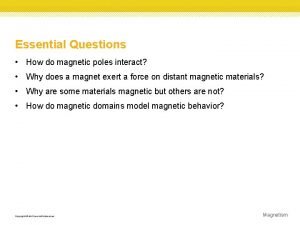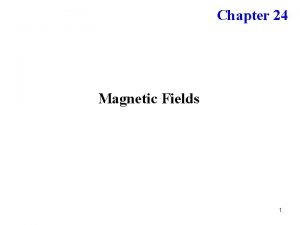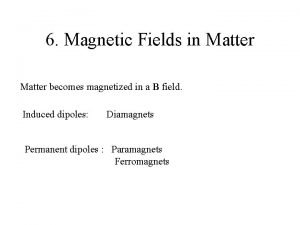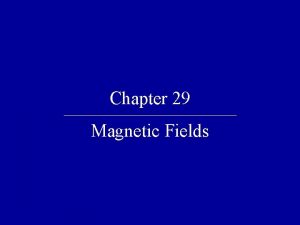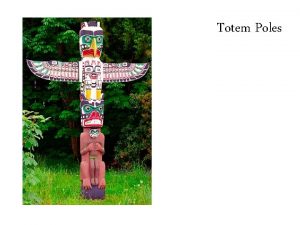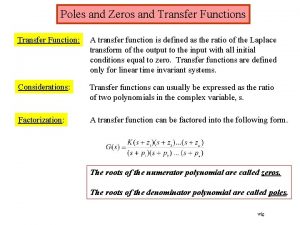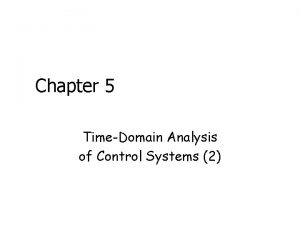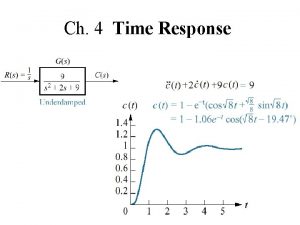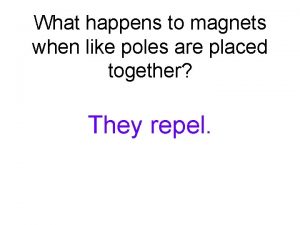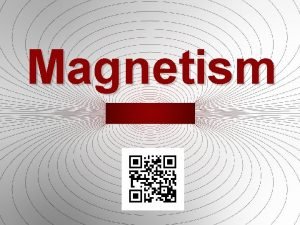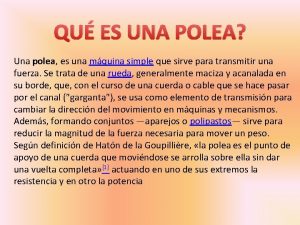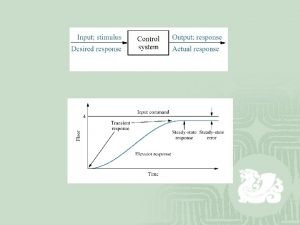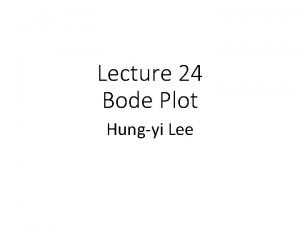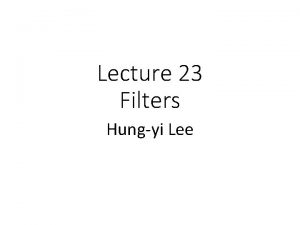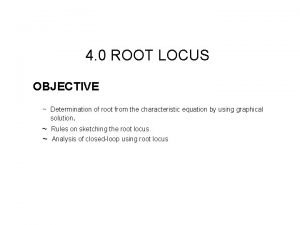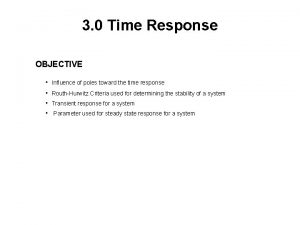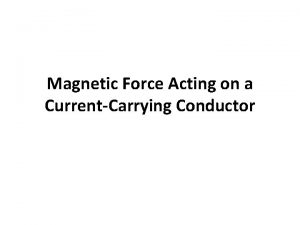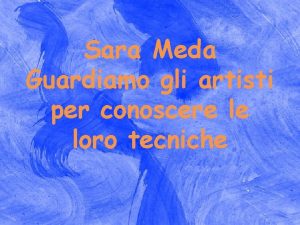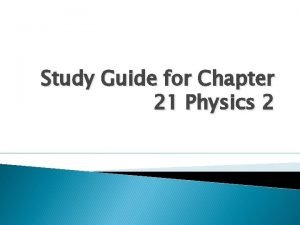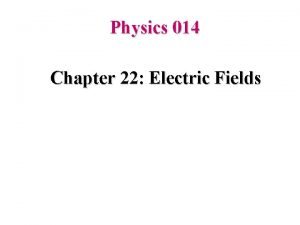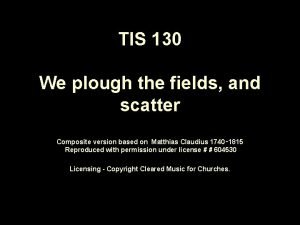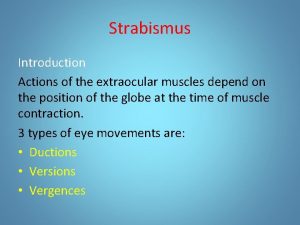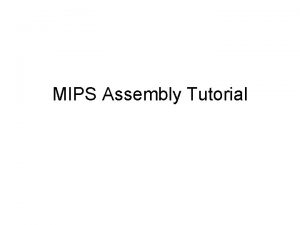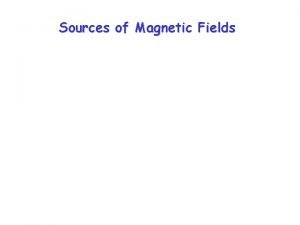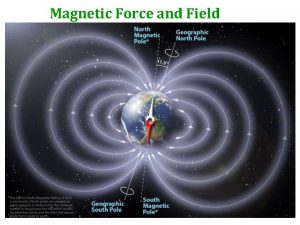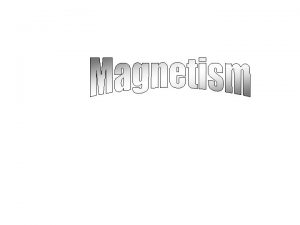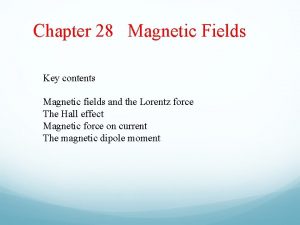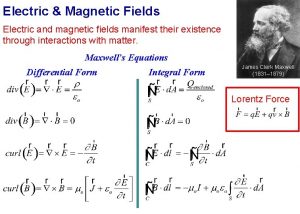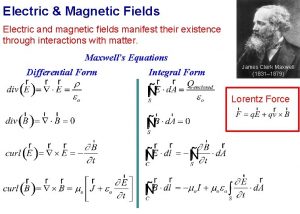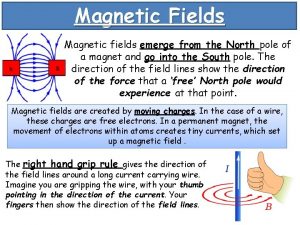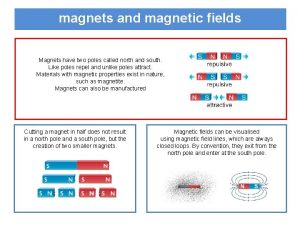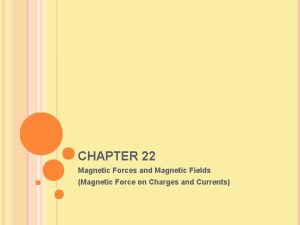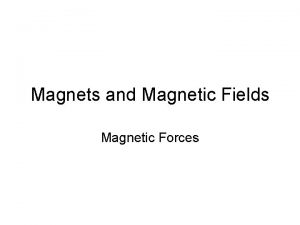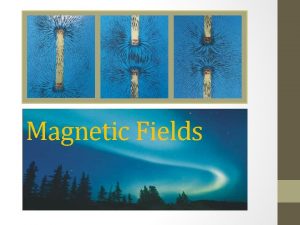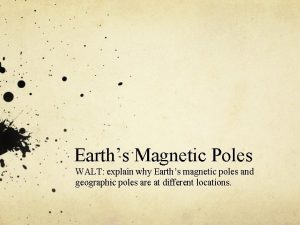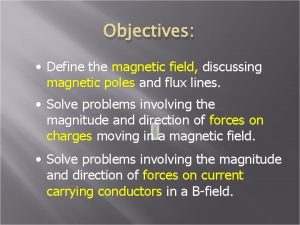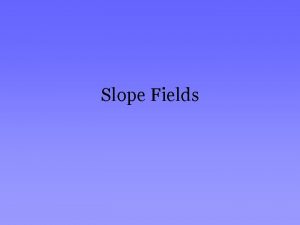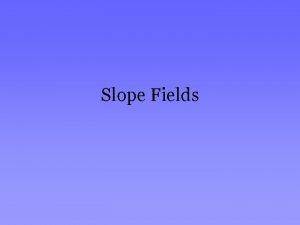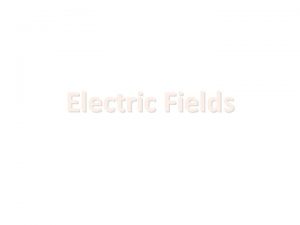Chapter 32 Magnetic Fields 1 Magnetic Poles Every



















































- Slides: 51

Chapter 32 Magnetic Fields 1

Magnetic Poles • Every magnet, regardless of its shape, has two poles – Called north and south poles – Poles exert forces on one another • Similar to the way electric charges exert forces on each other • Like poles repel each other – N-N or S-S • Unlike poles attract each other – N-S • The force between two poles varies as the inverse square of the distance between them • A single magnetic pole has never been isolated 2

Magnetic Fields Ø Magnetic Field is Created by the Magnets Ø A vector quantity, Symbolized by B Ø Direction is given by the direction a north pole of a compass needle points in that location Ø Magnetic field lines can be used to show the field lines, as traced out by a compass, would look 3

Chapter 32 Sources of the Magnetic Field 4

Sources of Magnetic Field Real source of Magnetic Field – Ø moving electric charges or Ø electric current Inside every magnet – electric currents 5

Sources of Magnetic Field Inside every magnet – electric currents S N no magnetic field 6

Biot-Savart Law • The magnetic field is d. B at some point P • The length element is ds • The wire is carrying a steady current of I • The magnitude of d. B is proportional to the current and to the magnitude ds of the length element ds • The magnitude of d. B is proportional to sin q, where q is the angle between the vectors ds and • The vector d. B is perpendicular to both ds and to the unit vector directed from ds toward P • The magnitude of d. B is inversely proportional to r 2, where r is the distance from ds to P 7

Biot-Savart Law • The constant mo is called the permeability of free space Ø mo = 4 p x 10 -7 T. m / A 8

Magnetic Field • The SI unit of magnetic field is tesla (T) 9

Biot-Savart Law: Total Magnetic Field Ø d. B is the field created by the current in the length segment ds Ø To find the total field, sum up the contributions from all the current elements Ids The integral is over the entire current distribution 10

Magnetic Field compared to Electric Field Distance Ø The magnitude of the magnetic field varies as the inverse square of the distance from the source Ø The electric field due to a point charge also varies as the inverse square of the distance from the charge Direction Ø The electric field created by a point charge is radial in direction Ø The magnetic field created by a current element is perpendicular to both the length element ds and the unit vector Source Ø An electric field is established by an isolated electric charge Ø The current element that produces a magnetic field must be part of an extended current distribution 11

Magnetic Field of a Long Straight Conductor • The thin, straight wire is carrying a constant current • Integrating over all the current elements gives 12

Magnetic Field of a Long Straight Conductor • If the conductor is an infinitely long, straight wire, q 1 = 0 and q 2 = p • The field becomes 13

Magnetic Field of a Long Straight Conductor • The magnetic field lines are circles concentric with the wire • The field lines lie in planes perpendicular to to wire • The magnitude of B is constant on any circle of radius a 14

Magnetic Field for a Curved Wire Segment • Find the field at point O due to the wire segment • I and R are constants Ø q will be in radians 15

Magnetic Field for a Curved Wire Segment • Consider the previous result, with q = 2 p • This is the field at the center of the loop R O I 16

Example 1 Determine the magnetic field at point A. A 17

Example 2 Determine the magnetic field at point A. A 18

Example 3 Two parallel conductors carry current in opposite directions. One conductor carries a current of 10. 0 A. Point A is at the midpoint between the wires, and point C is a distance d/2 to the right of the 10. 0 -A current. If d = 18. 0 cm and I is adjusted so that the magnetic field at C is zero, find (a) the value of the current I and (b) the value of the magnetic field at A. d/2 19

Example 3 Two parallel conductors carry current in opposite directions. One conductor carries a current of 10. 0 A. Point A is at the midpoint between the wires, and point C is a distance d/2 to the right of the 10. 0 -A current. If d = 18. 0 cm and I is adjusted so that the magnetic field at C is zero, find (a) the value of the current I and (b) the value of the magnetic field at A. d/2 20

Example 4 The loop carries a current I. Determine the magnetic field at point A in terms of I, R, and L. 21

Example 4 The loop carries a current I. Determine the magnetic field at point A in terms of I, R, and L. 22

Example 4 The loop carries a current I. Determine the magnetic field at point A in terms of I, R, and L. 23

Example 5 A wire is bent into the shape shown in Fig. (a), and the magnetic field is measured at P 1 when the current in the wire is I. The same wire is then formed into the shape shown in Fig. (b), and the magnetic field is measured at point P 2 when the current is again I. If the total length of wire is the same in each case, what is the ratio of B 1/B 2? 24

Example 5 A wire is bent into the shape shown in Fig. (a), and the magnetic field is measured at P 1 when the current in the wire is I. The same wire is then formed into the shape shown in Fig. (b), and the magnetic field is measured at point P 2 when the current is again I. If the total length of wire is the same in each case, what is the ratio of B 1/B 2? 25

Chapter 32 Ampere’s Law 26

Ampere’s law states that the line integral of Bds around any closed path equals where I is the total steady current passing through any surface bounded by the closed path. n 27

Field due to a long Straight Wire • Need to calculate the magnetic field at a distance r from the center of a wire carrying a steady current I • The current is uniformly distributed through the cross section of the wire 28

Field due to a long Straight Wire • The magnitude of magnetic field depends only on distance r from the center of a wire. • Outside of the wire, r > R 29

Field due to a long Straight Wire • The magnitude of magnetic field depends only on distance r from the center of a wire. • Inside the wire, we need I’, the current inside the amperian circle 30

Field due to a long Straight Wire • The field is proportional to r inside the wire • The field varies as 1/r outside the wire • Both equations are equal at r = R 31

Magnetic Field of a Toroid • Find the field at a point at distance r from the center of the toroid • The toroid has N turns of wire 32

Magnetic Field of a Solenoid • A solenoid is a long wire wound in the form of a helix • A reasonably uniform magnetic field can be produced in the space surrounded by the turns of the wire 33

Magnetic Field of a Solenoid • The field lines in the interior are – approximately parallel to each other – uniformly distributed – close together • This indicates the field is strong and almost uniform 34

Magnetic Field of a Solenoid • The field distribution is similar to that of a bar magnet • As the length of the solenoid increases – the interior field becomes more uniform – the exterior field becomes weaker 35

Magnetic Field of a Solenoid • An ideal solenoid is approached when: – the turns are closely spaced – the length is much greater than the radius of the turns • Consider a rectangle with side ℓ parallel to the interior field and side w perpendicular to the field • The side of length ℓ inside the solenoid contributes to the field – This is path 1 in the diagram 36

Magnetic Field of a Solenoid • Applying Ampere’s Law gives • The total current through the rectangular path equals the current through each turn multiplied by the number of turns • Solving Ampere’s law for the magnetic field is – n = N / ℓ is the number of turns per unit length • This is valid only at points near the center of a very long solenoid 37

Chapter 32 Interaction of Charged Particles with Magnetic Field 38

Interaction of Charged Particles with Magnetic Field • The properties can be summarized in a vector equation: FB = q v x B – FB is the magnetic force – q is the charge – v is the velocity of the moving charge – B is the magnetic field 39

Interaction of Charged Particle with Magnetic Field • The magnitude of the magnetic force on a charged particle is FB = |q| v. B sin q Ø q is the smallest angle between v and B – FB is zero when v and B are parallel or antiparallel Øq = 0 or 180 o – FB is a maximum when v and B are perpendicular Øq = 90 o 40

Direction of Magnetic Force • The fingers point in the direction of v • B comes out of your palm – Curl your fingers in the direction of B • The thumb points in the direction of v x B which is the direction of FB 41

Direction of Magnetic Force • Thumb is in the direction of v • Fingers are in the direction of B • Palm is in the direction of FB – On a positive particle – You can think of this as your hand pushing the particle 42

Differences Between Electric and Magnetic Fields • Direction of the force – The electric force acts along the direction of the electric field – The magnetic force acts perpendicular to the magnetic field • Motion – The electric force acts on a charged particle regardless of whether the particle is moving – The magnetic force acts on a charged particle only when the particle is in motion 43

Differences Between Electric and Magnetic Fields • Work – The electric force does work in displacing a charged particle – The magnetic force associated with a steady magnetic field does no work when a particle is displaced • This is because the force is perpendicular to the displacement 44

Work in Magnetic Field • The kinetic energy of a charged particle moving through a magnetic field cannot be altered by the magnetic field alone • When a charged particle moves with a velocity v through a magnetic field, the field can alter the direction of the velocity, but not the speed or the kinetic energy 45

Magnetic Field • The SI unit of magnetic field is tesla (T) 46

Force on a Wire • The magnetic force is exerted on each moving charge in the wire – F = q vd x B • The total force is the product of the force on one charge and the number of charges – F = (q vd x B)n. AL • In terms of current: F=ILx. B – L is a vector that points in the direction of the current • Its magnitude is the length L of the segment 47

Force on a Wire • Consider a small segment of the wire, ds • The force exerted on this segment is F = I ds x B • The total force is 48

Force on a Wire: Uniform Magnetic Field • B is a constant • Then the total force is • For closed loop: • The net magnetic force acting on any closed current loop in a uniform magnetic field is zero 49

Magnetic Force between two parallel conductors • Two parallel wires each carry a steady current • The field B 2 due to the current in wire 2 exerts a force on wire 1 of F 1 = I 1 ℓ B 2 • Substituting the equation for B 2 gives 50

Magnetic Force between two parallel conductors • Parallel conductors carrying currents in the same direction attract each other • Parallel conductors carrying current in opposite directions repel each other • The result is often expressed as the magnetic force between the two wires, FB • This can also be given as the force per unit length: 51
 Red fields to green fields
Red fields to green fields Why do magnets repel
Why do magnets repel How do similar (s-s or n-n) magnetic poles interact?
How do similar (s-s or n-n) magnetic poles interact? Learning: module 26: magnetic forces and fields
Learning: module 26: magnetic forces and fields Magnetism lesson outline answer key
Magnetism lesson outline answer key Magnetic field in matter
Magnetic field in matter Magnetic force quiz
Magnetic force quiz Electric currents and magnetic fields
Electric currents and magnetic fields Visualizing magnetic field
Visualizing magnetic field Every nation and every country has its
Every nation and every country has its Microsoft's mission statement
Microsoft's mission statement Every knee shall bow every tongue confess
Every knee shall bow every tongue confess Every rotarian every year
Every rotarian every year Every nation and every country
Every nation and every country Every picture has a story and every story has a moment
Every picture has a story and every story has a moment Every child every day
Every child every day Bumblebee totem pole
Bumblebee totem pole Poles of transfer function
Poles of transfer function Principles of first aid
Principles of first aid Settling time
Settling time Underdamped response
Underdamped response What happens when like poles are placed together
What happens when like poles are placed together Totem poles pictures
Totem poles pictures Magnetic field lines that curve away from each other show
Magnetic field lines that curve away from each other show Que es una poela
Que es una poela Underdamped poles
Underdamped poles Complex poles
Complex poles Second order band pass filter transfer function
Second order band pass filter transfer function Complex poles
Complex poles Complex poles
Complex poles A wire suspended vertically between the poles of a magnet
A wire suspended vertically between the poles of a magnet Are forces
Are forces Pollock blue poles
Pollock blue poles The coercive force in a ferromagnetic material is
The coercive force in a ferromagnetic material is Weber unit of magnetic flux
Weber unit of magnetic flux Magnetic moment and magnetic field relation
Magnetic moment and magnetic field relation Force on charged particle
Force on charged particle Chapter 16: electric forces and fields answers
Chapter 16: electric forces and fields answers Chapter 33 conceptual physics
Chapter 33 conceptual physics Chapter 21 study guide electric fields answers
Chapter 21 study guide electric fields answers Electric field for a disk
Electric field for a disk Norm rule fields
Norm rule fields How many fields in computer science
How many fields in computer science Electric forces and fields concept review
Electric forces and fields concept review We plow the fields and scatter
We plow the fields and scatter Posterior lung fields
Posterior lung fields Hirschburg test
Hirschburg test 6 cardinal fields of gaze
6 cardinal fields of gaze Stealing carol ann duffy
Stealing carol ann duffy Slope fields ap calculus
Slope fields ap calculus New consultant training
New consultant training Spim tutorial
Spim tutorial

